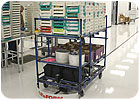
The Creform AGV, Agnes,
makes a continuous loop around the production floor of the HVHC Inc. plant in
Schertz, TX. Photo courtesy Creform Corp.
Based in Camp Hill, PA, HVHC Inc. is the parent company of Eye Care Centers of America Inc., the third largest retail optical chain in the country with more than 500 stores in 36 states. To meet Eye Care Centers’ need for product, HVHC has to produce huge quantities of glasses in an array of configurations, in an efficient, cost-effective manner. This led to the opening of a modern new plant in Schertz, TX.
“When we built our new plant, we installed several conveyors to move product throughout the facility,” recalls Ric Lee, HVHC’s manager of quality operations. “One of the problems, though, was we still had several smaller-volume material-handling applications that were being addressed by people pushing carts between multiple locations. We couldn’t figure out an economically justifiable conveyor system that would work for those applications.”
The plant’s conveyor systems had been designed, laid out and installed by NCC Automated Systems Inc. of Telford, PA. When HVHC contacted NCC looking for ways to make the remaining handcart applications more efficient, NCC showed them several options, including an automated guided vehicle (AGV) from Creform Corp., which HVHC has named Agnes.
“We looked into it and found that conveyors for just one of these applications would cost more than $140,000,” says Lee.
This AGV system is inherently flexible. Agnes can be custom-configured using the Creform System with its plastic-coated steel pipe, joints and hardware accessories. Once the upper vehicle structure is complete, the drive module and power source are added. Drive options include 12- or 24-volt power supplies, single or bidirectional units, and brakes for controlled, precise stops.
Installation of Agnes was inexpensive and did not interrupt production. There was no need to dig a trench in the floor. The vehicle requires only an adhesive-backed magnetic tape on the floor to designate its guide path. The tape is read by a magnetic induction sensor mounted on the cart. To change the AGV’s route as production dictates, HVHC simply modifies the tape path.
“It was up and ready less than an hour after they got it here,” says Lee.
Agnes makes a continuous loop around the production floor, stopping at 10 stations for one minute each to load or unload trays containing lenses or eyeglass frames, boxes of lenses, cases of frames or small totes of metal alloy. With the exception of the metal alloy, the items were loaded at eight stations and unloaded at two stations-operations support and shipping-both of which are located on the fringes of the facility near the door. Also, HVHC can quickly increase or decrease Agnes’ stop time as necessary.
“With the old way, we sometimes had spoilage issues,” says Lee. “You have stacks of trays on top of a cart and you run into something and the trays fall over and then you have lenses all over the floor.”
Lee also likes the fact that the new system keeps people at their workstations, which increases production. Because of increased production, the ROI on Agnes was less than six months.
For more information on automated guided vehicles, call 800-839-8823 or visit www.creform.com.


